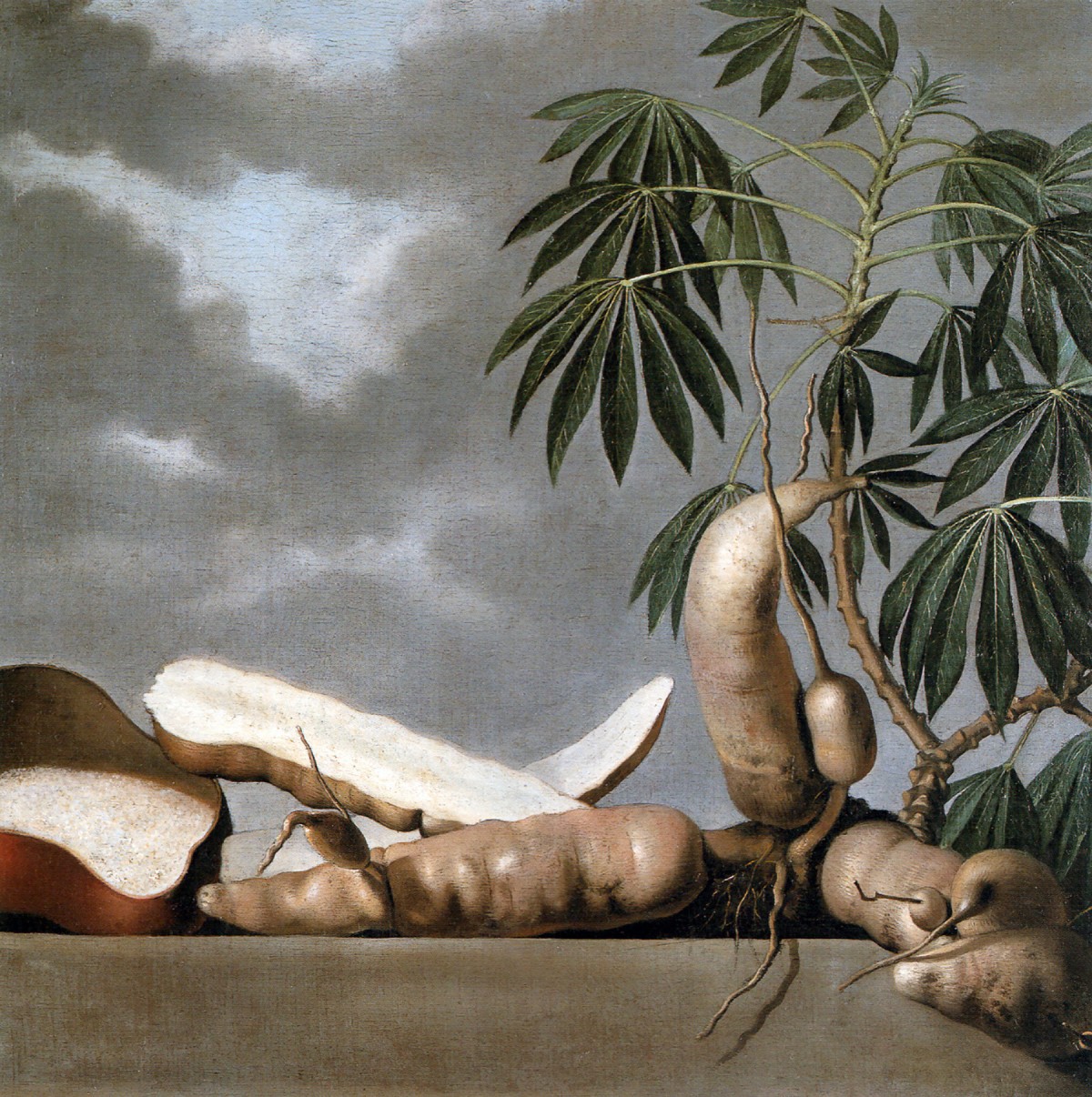Manioc was likely domesticated about 10,000 years ago in west-central Brazil from wild populations of M. esculenta subs. flabellifolia. When Columbus arrived at Hispaniola in 1492, manioc was a stable crop across the Caribbean, Brazil, and the New World tropics.
Humans domesticated both bitter and sweet forms of cassava. The bitter types have high levels of cyanogenic glycosides, which must be removed. This is done by peeling, grating, boiling, and draining. The resulting pulp is then used directly to make a kind of bread, or it is dried and powdered for later consumption after frying. The grated manioc is also squeezed in porous tubes made of basketry and the resulting sap is used for sauces and alcoholic beverages. Tapioca is prepared by partially cooking small pellets of cassava starch.
Soon after the Portuguese slave trade began, manioc was introduced to West Africa from Brazil. Manioc flour was one of the main commodities used by the Portuguese in exchange for African slaves, and by 1600, it was a common staple food in the coastal areas dominated by them. It was known in Angola as farinha do Brasil (Brazilian flour), in contrast to farinha da Europa (European or wheat flour). Manioc was brought from Brazil to the Island of São Tomé sometime between 1600 and 1620, and to the Kongo kingdom and Angola by 1625. The area surrounding the Portuguese capitol of Luanda in Angola became a center of manioc production, which was used to pay for slaves brought from interior regions and supply traders from other African ports.
Over the next 250 years, manioc cultivation spread slowly but steadily across Africa. The French brought manioc cultivation to Eastern Africa in the 1730s, when they introduced it into their colonies of Mauritius, Reunion, and Madagascar. In the mid-1700s, the Portuguese took manioc to Tanzania, Kenya, Zanzibar, and Mozambique. In West Africa, manioc gained a major foothold in the 1840s when ex-slaves from northern Brazil were repatriated to the Bight of Benin. During the nineteenth century, manioc cultivation gradually spread inland from the eastern coast to the upper Congo where it joined up with manioc farming that had spread from west central Africa in the opposite direction. During the European colonial period in the late nineteenth century, manioc became a major staple crop across Africa.
Manioc was also introduced into Indonesia by the Portuguese in the 17th century, but it remained relatively unimportant until the mid-1800s when its acreage suddenly began to surge. Drought and food shortages had stimulated a quest for alternative food crops, and the government of Java began introducing new manioc varieties in the 1840s from the West Indies. By 1892 twenty-one of the twenty-five Java Residencies were growing manioc, and its acreage continued to increase over the next 80 years until Java became one of the largest cassava producers of the world. During the 1800s manioc acreage also expanded dramatically across the entire Indonesian Archipelago and SE Asia, and by 1880 had become the most important root and tuber crop.
Manioc is now the sixth most important food crop in the world, grown widely across the tropics and subtropics. Although a perennial plant, it is extensively cultivated as an annual crop for its edible starchy tuberous root, a major source of carbohydrates. It is far more productive on a per hectare acre than any other food crop.
Bibliography:
Boomgaard, P. (2003). In the shadow of rice: Roots and tubers in Indonesian history, 1500-1950. Agricultural History 77: 582-610.
Freitas, F. (2019). The South Atlantic Columbian Exchange. Europe, 10: 1-12.
Hancock, J.F. (2022) World Agriculture before and after 1492: Legacy of the Columbian Exchange. Springer
Illustration: Manioc (Cassava) – Albert Eckhout (1610-1666), National Museum of Denmark, RKDimages ID
